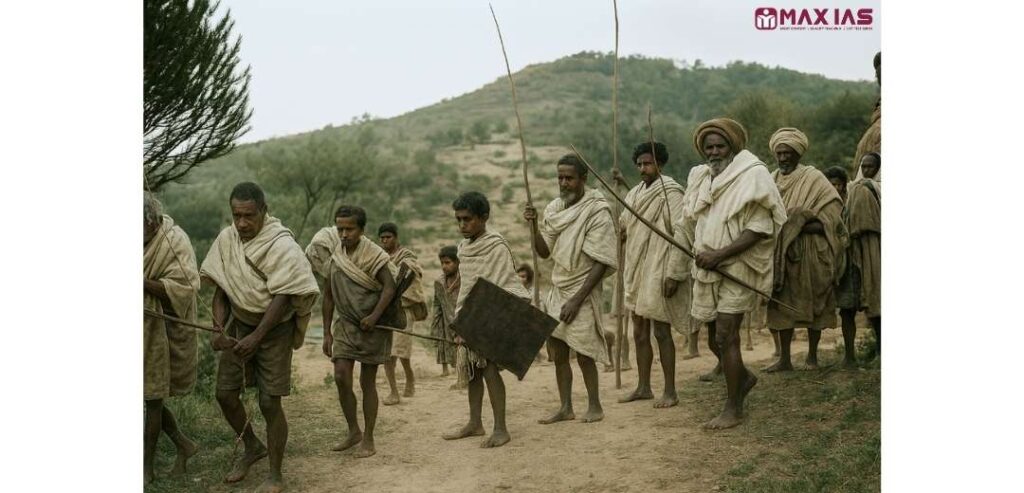Tarak Chandra Das (1898-1964), during Das time, the first department of Anthropology in India was established at the University of Calcutta in 1920.
Das’s brilliant Monograph, The Purums: An Old Kuki tribe of Manipur, published in 1945 by Calcutta University, became one of the major sources of the database for the debate on descent versus alliance theories in Kinship.

Purums holding weapons
The Purums have comparatively a small number of relationship terms . Many of these terms are used in respect of more than one relative. Some of these indicate seven or eight or even ten relatives. The grouping of different relatives under the same term is often connected with Purum marriage customs or with classificatory ideas.
Marriage with the mother’s brother’s daughter is the most widely practised type of union.Where actual mother’s brother’s daughter is not available they try to secure a bride from the sib of the mother’s brother. Thus we find the prevalence of one type of cross cousin marriage to the entire exclusion of the other type. Side by side with this prescriptive rule there is the proscriptive rule that a man must not marry his father’s sister’s daughter.
These two features of their marriage customs find ample expression in the terms of relationship.
Generally speaking, the sex of the relative is indicated by the addition of the suffixes pa and nu, respectively, for male and female. But in one case, this differentiation is not maintained. Thus Ka-terr indicates both the father’s elder brother and his wife on the one hand and the mother’s elder sister and her husband on the other.
Different terms are generally used by the. Purums to indicate older and younger relatives of the same generation as the speaker. Thus,
the elder brother is Ka-ata and the younger Kanaupa;
the elder sister is ka-u and the younger sister kanaunu;
the elder brother’s wife is ku-u , while the younger brother’s wife is kanaunu etc.
This differentiation is also met with in the immediate higher, generation of speaker specially among the father’s brothers and mothej’s sisters.
The father’s elder brother is ka-terr and his younger brother kapate.
But there is no.distinction between the sisters of the father. They are all known by the same term namely ka-ni.
In the same, way the mother’s elder and younger sisters are distinguished by the terms ka-terr and kanute respectively, while her brothers are all known by a single term namely kapu.
The distinction in the preceding two cases that is among the brothers of the father and sisters of the mother, does not seem to be due to recognition of age-difference. Had it been so we would have met with the same tendency among the sisters of the father and brothers of the mother. It is perhaps due to marriage customs. The distinction among the brothers of the father is perhaps due to the practice of junior levirate with the exclusion of senior levirate while that among the sisteys of the mother may be attributed, to a custom by which a number of sisters could be married by a number of brothers according to seniority of age i.e., the eldest brother was to marry the eldest sister and the next brother the next sister and so on.
Some of the terms include relatives of different generations as for example kapu, kapi, katupa, kattini, etc.
The term kapu is used by a man to indicate his father’s father as well as all male agnates of his generation and the generations above him. This term also refers to the father’s father’s sister’s husband and probably the husbands of all the daughters of the family in higher generations.
The term kapu is also used to refer to all the males of the mother’s father’s and wife’s father’s families which are practically the same where marriage with the mother’s brother’s daughter is practised. Thus, on this side, kapu includes the mother’s father, mother’s brother, wife’s father, mother’s brother’s son, wife’s elder brother and wife’s brother’s son. Kapi also refers to the wives of the same relatives. .
In the same way katupa is used to indicate the son’s son and alll males of his own and succeeding generations with whom blood relationship can be traced. The comprehensive nature of these terms indicates that they are either terms of honour or of endearment.
Another marriage custom namely, “junior’ levirate-‘seems to be reflected in purum terms of relationship.
Thus kapate is father’s younger brother and at the same, time the step-father
Kapa indicates the father and by adding the suffix ‘ te ’ which means ‘ small ’ we get the term kapate —meaning the small father or rather the step-father. In connection with marriage rules we have seen that levirate of both the t ypes viz., junior and senior, is found among the Purums. But the terms of relationship only support the existence of the junior type. The term kanute refers to the mother’s younger sister as well as the step-mother. This may point to the existence of sorrorate. This term is also formed in the same way as kapate.Kanu indicates mother; ‘ te ’ (meaning small) is added to it in order to mean the step-mother and the mother’s younger sister. The mother’s younger sister is the potential wife of the father under sorrorate while the father’s younger brother is the potential husband of the mother under levirate.


